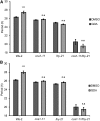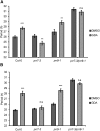HSP90 Contributes to Entrainment of the Arabidopsis Circadian Clock via the Morning Loop
- PMID: 30337341
- PMCID: PMC6283155
- DOI: 10.1534/genetics.118.301586
HSP90 Contributes to Entrainment of the Arabidopsis Circadian Clock via the Morning Loop
Abstract
The plant circadian clock allows the synchronization of internal physiological responses to match the predicted environment. HSP90.2 is a molecular chaperone that has been previously described as required for the proper functioning of the Arabidopsis oscillator under both ambient and warm temperatures. Here, we have characterized the circadian phenotype of the hsp90.2-3 mutant. As previously reported using pharmacological or RNA interference inhibitors of HSP90 function, we found that hsp90.2-3 lengthens the circadian period and that the observed period lengthening was more exaggerated in warm-cold-entrained seedlings. However, we observed no role for the previously identified interactors of HSP90.2, GIGANTEA and ZEITLUPPE, in HSP90-mediated period lengthening. We constructed phase-response curves (PRCs) in response to warmth pulses to identify the entry point of HSP90.2 to the oscillator. These PRCs revealed that hsp90.2-3 has a circadian defect within the morning. Analysis of the cca1, lhy, prr9, and prr7 mutants revealed a role for CCA1, LHY, and PRR7, but not PRR9, in HSP90.2 action to the circadian oscillator. Overall, we define a potential pathway for how HSP90.2 can entrain the Arabidopsis circadian oscillator.
Keywords: Arabidopsis; HSP90; circadian clock.
Copyright © 2018 by the Genetics Society of America.
Figures







Similar articles
-
A genetic study of the Arabidopsis circadian clock with reference to the TIMING OF CAB EXPRESSION 1 (TOC1) gene.Plant Cell Physiol. 2009 Feb;50(2):290-303. doi: 10.1093/pcp/pcn198. Epub 2008 Dec 19. Plant Cell Physiol. 2009. PMID: 19098071
-
The role of the Arabidopsis morning loop components CCA1, LHY, PRR7, and PRR9 in temperature compensation.Plant Cell. 2010 Nov;22(11):3650-61. doi: 10.1105/tpc.110.079087. Epub 2010 Nov 23. Plant Cell. 2010. PMID: 21098730 Free PMC article.
-
PSEUDO-RESPONSE REGULATORS, PRR9, PRR7 and PRR5, together play essential roles close to the circadian clock of Arabidopsis thaliana.Plant Cell Physiol. 2005 May;46(5):686-98. doi: 10.1093/pcp/pci086. Epub 2005 Mar 13. Plant Cell Physiol. 2005. PMID: 15767265
-
MYB transcription factors in the Arabidopsis circadian clock.J Exp Bot. 2002 Jul;53(374):1551-7. doi: 10.1093/jxb/erf027. J Exp Bot. 2002. PMID: 12096093 Review.
-
The role of CCA1 and LHY in the plant circadian clock.Dev Cell. 2002 May;2(5):516-8. doi: 10.1016/s1534-5807(02)00184-3. Dev Cell. 2002. PMID: 12015957 Review.
Cited by
-
Interaction between the Circadian Clock and Regulators of Heat Stress Responses in Plants.Genes (Basel). 2020 Feb 1;11(2):156. doi: 10.3390/genes11020156. Genes (Basel). 2020. PMID: 32024106 Free PMC article. Review.
-
ASTool: An Easy-to-Use Tool to Accurately Identify Alternative Splicing Events from Plant RNA-Seq Data.Int J Mol Sci. 2022 Apr 7;23(8):4079. doi: 10.3390/ijms23084079. Int J Mol Sci. 2022. PMID: 35456896 Free PMC article.
-
Recent advances in understanding regulation of the Arabidopsis circadian clock by local cellular environment.F1000Res. 2020 Jan 27;9:F1000 Faculty Rev-51. doi: 10.12688/f1000research.21307.1. eCollection 2020. F1000Res. 2020. PMID: 32047621 Free PMC article. Review.
-
BRI1 and BAK1 Canonical Distribution in Plasma Membrane Is HSP90 Dependent.Cells. 2022 Oct 22;11(21):3341. doi: 10.3390/cells11213341. Cells. 2022. PMID: 36359737 Free PMC article.
-
The intersection between circadian and heat-responsive regulatory networks controls plant responses to increasing temperatures.Biochem Soc Trans. 2022 Jun 30;50(3):1151-1165. doi: 10.1042/BST20190572. Biochem Soc Trans. 2022. PMID: 35758233 Free PMC article. Review.
References
Publication types
MeSH terms
Substances
Associated data
Grants and funding
LinkOut - more resources
Full Text Sources
Other Literature Sources
Molecular Biology Databases
Research Materials

